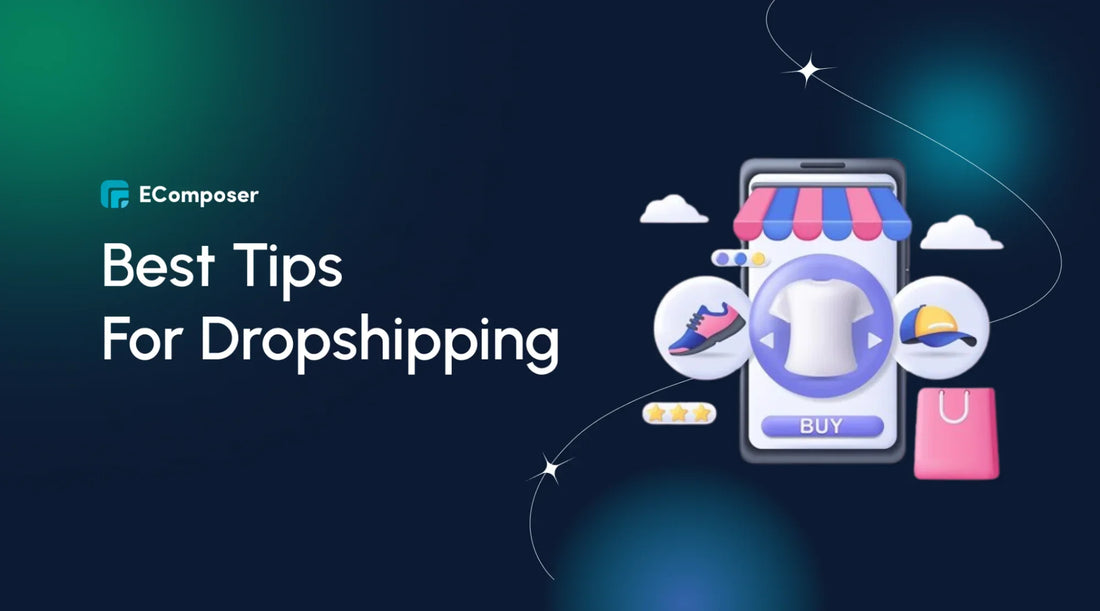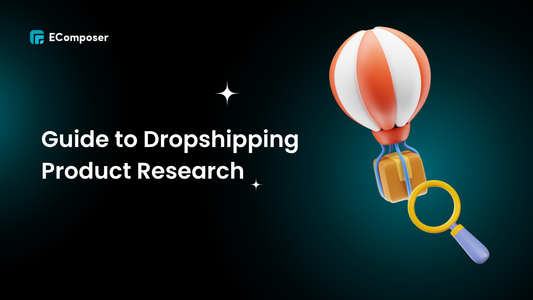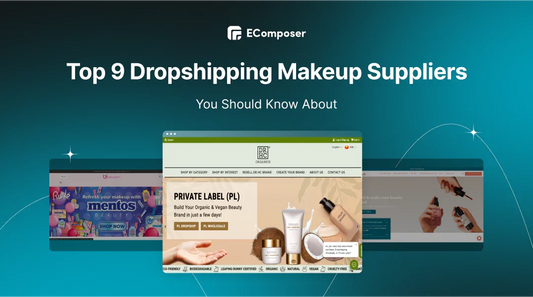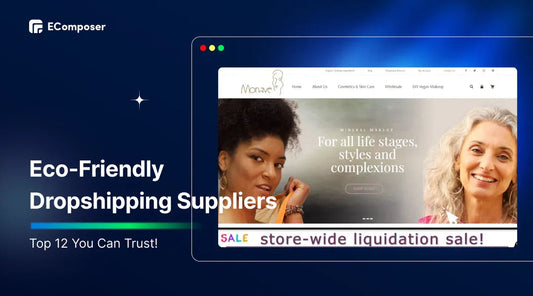17 Best Tips For 2025 Dropshipping To Maximize Profits

Table Of Contents
With the dropshipping market soaring, valued at a staggering USD 222.46 Billion in 2022 and projected to grow at a remarkable CAGR of 28.4% until 2031 (Straits Research), it's time to harness the potential. Dive into our expert tips for dropshipping and strategies to stay ahead in this dynamic industry and elevate your profitability like never before. Let's embark on this journey to success together!
What is Dropshipping?

Dropshipping is a retail fulfillment approach where the store doesn't retain the products it sells in stock. Instead, upon making a sale, the store buys the item from a third party and arranges for it to be shipped directly to the customer. In essence, the seller serves as a middleman, facilitating the transaction without handling the product directly.
Here's how it works:
- Customer Places Order: A customer buys a product from your online store at a retail price.
- Order Forwarded to Supplier: The order details are forwarded to a supplier, often a wholesaler or manufacturer, who holds the inventory.
- Supplier Ships Directly to Customer: The supplier then ships the product directly to the customer's doorstep.
Why should you dropship?

Dropshipping offers several compelling reasons why it may be a suitable choice for aspiring entrepreneurs:
- Low Startup Costs: Start with minimal capital; no need to invest in inventory upfront, reducing financial risk.
- Flexibility: Experiment with products without inventory commitment, adapting quickly to market changes.
- No Need for Warehouse Space: Operate from anywhere with an internet connection; no warehouse management is required.
- Wide Product Selection: Offer diverse products without inventory hassles, potentially increasing sales.
- Scalability: Scale quickly with third-party fulfillment, focusing on expanding products and marketing.
- Reduce Operational Burden: Outsource inventory management, focusing on core business activities.
- Lower Risk of Overstocking: Minimize overstocking risk; no need to purchase inventory upfront, improving cash flow management.
Overall, dropshipping offers a low-risk, high-reward business model that appeals to entrepreneurs looking for flexibility, scalability, and minimal upfront investment.
17+ Dropshipping Tips You Need To Know
1. Potential Niche Selection

Niche selection is pivotal in dropshipping, offering focus and differentiation. By targeting specialized markets, businesses reduce competition, increase relevance, and improve conversion rates. Niche businesses foster stronger connections with customers, positioning themselves as authorities in their field. This approach allows for scalability and growth opportunities.
- Research Market Trends: Explore trending topics, interests, and emerging industries to identify potential niches with high demand.
- Analyze Competitor Landscape: Study competitors within potential niches to assess competition levels, market saturation, and opportunities for differentiation.
- Consider Personal Interests: Evaluate your own interests, hobbies, and passions to identify niches that align with your expertise and passion.
- Assess Profitability: Investigate the profit potential of potential niches by analyzing product pricing, profit margins, and customer willingness to pay.
- Validate Market Demand: Use market research tools, keyword analysis, and social media trends to validate product demand within potential niches.
- Narrow Down Options: Refine your list of potential niches based on profitability, market demand, competition, and personal interest.
- Evaluate Target Audience: Understand the target audience's demographics, preferences, and pain points within each potential niche.
- Identify Unique Selling Proposition (USP): Determine what sets your business apart within each potential niche and how you can offer unique value to customers.
- Consider Long-Term Viability: Assess potential niches' long-term sustainability and growth potential to ensure they align with your business goals and objectives.
Explore here: 19+ Top Trending Niches for 2025
2. Know Your Customers

Understanding your customers is fundamental to thriving in dropshipping endeavors. It enables tailored product offerings, targeted marketing, and personalized customer experiences. By understanding their demographics, preferences, and behaviors, you can build stronger relationships, drive loyalty, and gain a competitive edge. Customer insights also guide strategic decisions, ensuring that you continuously evolve to meet your audience's changing needs and expectations.
- Collect Customer Data: Utilize surveys, feedback forms, and analytics tools to gather information on demographics, preferences, and purchase behavior.
- Segment Your Audience: Segment your customer base based on factors such as age, location, interests, and buying habits to tailor marketing efforts.
- Create Buyer Personas: To better understand your customers' needs, develop detailed profiles of them, including their goals, challenges, motivations, and pain points.
- Monitor Social Media: Engage with customers on social media platforms to observe conversations, trends, and sentiments related to your products and industry.
- Analyze Website Analytics: Utilize website analytics tools to monitor user behavior, including page views, bounce rates, and time spent on site, to gather insights into customer preferences and interests.
- Conduct Market Research: Keep abreast of industry trends, competitor strategies, and market dynamics through market research reports, industry publications, and competitor analysis.
- Engage in Direct Communication: Communicate directly with customers through email newsletters, live chat, and customer service interactions to gather feedback and build relationships.
- Track Customer Interactions: Keep records of customer interactions, including inquiries, complaints, and purchases, to identify patterns and trends in customer behavior.
- Use Customer Relationship Management (CRM) Software: Implement CRM software to centralize customer data, track interactions, and segment audiences for personalized communication.
- Regularly Review and Update Customer Profiles: Continuously review and update customer profiles as new data becomes available to ensure accuracy and relevance in your marketing efforts.
3. Winning Products
Selecting winning products ensures revenue growth, customer satisfaction, and market differentiation. These products generate consistent sales, bolster brand reputation, and provide a competitive edge. Curating a selection of high-quality, in-demand items satisfies customer needs and lays the groundwork for business scalability and long-term success in the dynamic eCommerce landscape.
- Market Research: Leverage tools like Google Trends, Amazon Best Sellers, and social media platforms to identify trending products and niches with high demand.
- Competitor Analysis: Study competitors' product offerings and sales performance to identify potential winning products and gaps in the market.
- Product Validation: Test potential winning products by listing them in your store or conducting market research surveys to gauge interest and demand.
- Customer Feedback: Collect feedback from current customers to comprehend their preferences, pain points, and product suggestions.
- Supplier Partnerships: Collaborate with reliable suppliers who offer quality products at competitive prices to ensure consistent availability of winning items.
- Seasonal Trends: Monitor seasonal trends and upcoming holidays to capitalize on opportunities for seasonal products or gift items.
- Evaluate Profitability: Analyze profit margins, shipping costs, and potential competition to assess the profitability of potential winning products.
- Niche Selection: Focus on niche markets or specialized product categories where you can establish a unique selling proposition and target a specific audience.
- Product Reviews and Ratings: Research product reviews and ratings on platforms like Amazon and eBay to identify products with positive feedback and customer satisfaction.
- Stay Updated: Monitor industry trends, consumer behavior, and market dynamics to adapt your product selection and stay ahead of the competition.
Read more:
4. Analyze Competitors

Analyzing competitors provides insights into market trends, customer preferences, and effective strategies. By understanding competitors' strengths and weaknesses, businesses can identify opportunities for differentiation, benchmark performance, and set competitive prices. This knowledge enables strategic positioning and informed decision-making to stay ahead in the dynamic dropshipping landscape.
- Competitor Research: Conduct online research and analyze marketplaces like Amazon and eBay to identify key competitors in your niche or industry.
- SWOT Analysis: Conduct a SWOT (Strengths, Weaknesses, Opportunities, Threats) analysis of competitors to understand their positioning and potential areas of vulnerability.
- Product Comparison: Compare competitors' product offerings, pricing, and features to identify gaps and opportunities for differentiation.
- Customer Feedback: Gather and analyze customer feedback and reviews for competitors' products to understand customer satisfaction and identify areas for improvement.
- SEO Analysis: Analyze competitors' SEO strategies, including keywords, backlinks, and content, to identify opportunities to improve your own website's visibility and rankings.
- Social Media Monitoring: Monitor competitors' social media channels to track their engagement, content strategies, and customer interactions.
- Stay Updated: Continuously monitor competitors' activities, Incorporate details on new product releases, promotions, and marketing initiatives to remain informed and adaptable in the marketplace.
5. Best eCommerce Platform

A suitable eCommerce platform ensures streamlined operations, scalability for growth, and seamless integration with essential tools. With built-in SEO features and user-friendly interfaces, a top platform enhances visibility and customer experience. Prompt customer support and security measures further safeguard business operations, empowering entrepreneurs to focus on driving sales and maximizing profitability in the competitive eCommerce landscape.
Shopify distinguishes itself as a leading option for dropshipping ventures:
- User-Friendly Interface: Shopify simplifies store setup and management, ideal for beginners.
- Diverse App Ecosystem: Access a wide range of marketing, SEO, and inventory management apps.
- Scalability: Grow your business seamlessly with Shopify's adaptable platform.
- Built-In SEO Features: Boost store visibility with Shopify's built-in SEO tools.
- Mobile Responsiveness: Ensure a smooth shopping experience across devices.
- 24/7 Customer Support: Get reliable assistance whenever needed.
- Secure Payment Processing: Enjoy secure transactions with Shopify Payments and multiple gateways.
- Dropshipping Integration: Easily manage dropshipping operations within Shopify.
Explore here: Which Shopify Plan is Best for Dropshipping?
Shopify extends a special offer tailored for new merchants, just $1, to leverage its features in 33 days. Don’t miss out on the chance; the deal may end anytime. Click on the button below to sign up now!
Start by clicking on the sign-up link provided on the Shopify website. Once you're on the page, you'll notice a banner at the top that invites you to begin a 3-day free trial and subscribe to a 30-day extended plan for just $1.
Start 1 Month Trial Now!6. Stunning Online Stores

A visually appealing and fully functional online storefront is pivotal for dropshipping success and fostering trust, engagement, and conversions. It serves as the face of your brand, creating positive first impressions and reflecting your identity. With optimized design elements and seamless user experience, a stunning online store enhances credibility, boosts customer satisfaction, and ultimately drives sales in the competitive eCommerce landscape.
- Choose a High-Quality Theme: Select a professionally designed theme, such as Kalles, Gecko, Unsen, Ecomus, etc, that aligns with your brand aesthetic and offers the necessary features and customization options.
Explore here:
[20+] Best Converting Shopify Themes: Sales-Boosting
13+ Excellent Shopify 2.0 Themes FREE & Paid
- Customize Design Elements: Personalize your store's design by customizing colors, fonts, layouts, and imagery to create a cohesive and visually appealing look.
- Optimize for Mobile: Ensure your store is optimized for mobile devices, employing a responsive design that effortlessly adjusts to different screen sizes and resolutions.
- High-Quality Imagery: Use high-resolution images and professional photography to showcase your products in the best possible light and provide a visually engaging shopping experience.
- Straightforward Navigation: Streamline navigation by organizing products into logical categories and creating easy-to-find menus and navigation links for a user-friendly browsing experience.
- Compelling Product Descriptions: Write clear, concise, and persuasive product descriptions highlighting key features, benefits, and unique selling points to entice customers and encourage conversions.
After completing the signup process for a Shopify account, you can utilize EComposer, the #1 Drag and Drop Page Builder App on Shopify. This app allows you to build a complete Shopify store with any page type. It provides a rich library of stunning premade layouts and sections by eCommerce experts; these templates are crafted beautifully and optimized for the best speed and performance to ensure your conversion rate.
Besides, EComposer helps you elevate dropshipping stores with limitless built-in features and extensions such as cross-selling, order tracking, global block, unlimited blog posts, etc. Especially, you can start using EComposer from $0. Try it now!

Learn more here: How to Design a Shopify Store in 10 minutes
7. Impressive Store name
Selecting an impressive store name is crucial for branding and customer engagement in dropshipping. A standout name should be memorable, relevant to your niche, and easy to spell. It should evoke positive emotions and resonate with your target audience. Additionally, check domain availability and ensure the name aligns with your brand identity and values. A compelling store name sets the stage for building brand recognition and a solid online presence.
- Reflect Your Niche: Select a name that reflects the products or niche you specialize in. It should give customers an idea of what you offer.
- Unique and Memorable: Choose a name that is unique, memorable, and easy to spell. Avoid generic or overly complicated names.
- Consider Branding: Ensure the name aligns with your brand identity and values. It should resonate with your target audience and evoke positive emotions.
- Check Domain Availability: Verify that the domain name corresponding to your store name is available. Consistency across your store name and domain name is essential for branding.
- Legal Considerations: Check for trademarks and ensure the name you choose is not already in use by another business to avoid legal issues.
- Future Expansion: Consider future expansion plans and ensure the name is flexible enough to accommodate growth or diversification of product offerings.
- Online Search: Conduct online searches to ensure the name is not associated with negative connotations or existing businesses.
Read more:
8. Reliable Suppliers
Choosing reliable suppliers in dropshipping ensures consistent product quality, timely order fulfillment, and efficient communication. It reduces the risk of shipping delays, stockouts, and customer complaints, enhancing overall customer satisfaction. Reliable suppliers offer competitive pricing, allowing you to maintain profit margins and remain competitive. Additionally, they offer a wide variety of products, enabling you to expand your offerings and effectively cater to diverse customer preferences.
- Research and Due Diligence: Conduct thorough research and vet potential suppliers, considering factors such as reputation, reviews, and track record.
- Communication: Set up transparent communication channels with suppliers to discuss expectations, terms, and requirements and ensure ongoing collaboration and support.
- Sample Testing: Request samples of products from potential suppliers to assess quality, packaging, and shipping times before committing to a partnership.
- Check References: Seek references or recommendations from other dropshippers or industry peers to validate the reliability and reputation of potential suppliers.
- Transparency and Documentation: Ensure transparency regarding pricing, policies, and terms by carefully reviewing supplier contracts and agreements before finalizing partnerships.
- Monitor Performance: Continuously monitor supplier performance, including order fulfillment times, product quality, and customer feedback, to identify any issues and address them promptly.
Explore here:
- 17 Best Shopify Dropshipping Suppliers FREE
- 17 Best Dropshipping Suppliers for eCommerce Success
- 10 Home Decor Dropshipping Suppliers USA
- 21 Best Free Dropshipping Suppliers in USA
9. Price Tactics

Implementing price tactics in dropshipping is essential for remaining competitive, maximizing profits, and managing customer perceptions. It helps attract customers, optimize revenue, and balance margins effectively. Price tactics also enable demand management, inventory clearance, and brand positioning. Strategically adjusting prices based on market dynamics and customer behavior can achieve sustainable growth and success.
- Competitive Pricing: Analyze competitor pricing and adapt your prices to stay competitive while ensuring profitability.
- Dynamic Pricing: To optimize revenue, Utilize dynamic pricing strategies considering factors such as demand and seasonality, and competitor actions.
- Discounts and Promotions: Offer discounts, promotions, and bundle deals to attract customers and incentivize purchases.
- Free Shipping Thresholds: Set free shipping thresholds to encourage customers to spend more, increase the average order value, and offset shipping costs.
- Tiered Pricing: Offer tiered pricing options for bulk purchases or subscription models to appeal to different customer segments and increase customer lifetime value.
- Price Testing: Experiment with different pricing strategies and monitor their impact on sales and profitability to identify the most effective approach.
10. Order Fulfillment

Order fulfillment, the process of receiving, processing, and delivering customer orders, is critical in dropshipping. Efficient fulfillment ensures timely delivery, customer satisfaction, and repeat business. It reflects on brand reputation and influences customer loyalty. Streamlined fulfillment processes also optimize operational efficiency and scalability, enabling businesses to meet growing demand and maintain competitiveness.
- Automate Tasks: Implement automation for order processing, inventory management, and shipping to minimize manual errors and streamline workflows.
- Integrate Systems: Integrate your eCommerce platform with order management and inventory systems to ensure real-time data synchronization and seamless communication.
- Prioritize Fast Shipping: Partner with reliable shipping carriers and offer expedited shipping options to meet customer expectations for fast delivery.
- Optimize Inventory: Use demand forecasting and inventory planning to ensure optimal stock levels to prevent inventory shortages and overstock situations.
- Streamline Packaging: Standardize packaging processes and use efficient packaging materials to minimize waste and reduce shipping costs.
- Offer Tracking: Provide order tracking capabilities to customers, allowing them to monitor shipment status and reduce inquiries to customer support.
- Continuous Improvement: Regularly review and analyze order fulfillment metrics to spot bottlenecks and pinpoint areas needing enhancement, implementing changes to optimize efficiency.
- Train Staff: Offer training and support to staff members involved in fulfilling their obligations, ensuring they understand processes, and performing tasks efficiently.
- Implement Quality Control: Conduct regular quality checks on products and packaging to maintain standards and prevent shipping errors or damaged goods.
- Customer Communication: Keep customers informed about their order status through proactive communication, updates on shipping delays, and promptly resolve any issues.
11. Marketing strategies

Marketing in dropshipping enhances brand visibility, drives traffic, and boosts sales. It cultivates customer relationships, fosters brand loyalty, and establishes authority in the niche. Effective marketing tactics such as social media, SEO, and email campaigns attract qualified leads and convert them into paying customers.
- Social Media Marketing: Utilize platforms like Instagram, Facebook, and Pinterest to showcase products, engage with customers, and drive traffic to your store.
- Content Marketing: Generate valuable content such as blog posts, videos, and infographics to educate and inspire your audience, establishing your brand as a trusted authority in your niche.
- Email Marketing: Build an email list and send targeted campaigns to nurture leads, promote products, and drive sales through personalized offers and recommendations.
- Influencer Partnerships: Partner with influencers and bloggers within your niche to reach a larger audience and leverage their credibility and following to endorse your products.
- Search Engine Optimization (SEO): Enhance your website for search engines to boost visibility and rankings, drive organic traffic, and attract qualified leads.
- Pay-Per-Click (PPC) Advertising: Run targeted PPC campaigns on platforms like Google Ads and Bing Ads to reach potential customers actively searching for your products.
- Affiliate Marketing: Partner with affiliates to market your products and receive a commission based on sales, leveraging their networks to expand your reach and drive sales.
- Social Proof and Reviews: Encourage satisfied customers to leave reviews and testimonials, leveraging social proof to build trust and credibility with potential buyers.
- Retargeting Campaigns: Use retargeting ads to re-engage visitors who have shown interest in your products but have yet to make a purchase, reminding them to complete their purchase.
Learn more: 10 Proven Ways To Promote Your Shopify Store For Drive Sales
12. Excellent Customer Support

Excellent customer support in dropshipping fosters satisfaction, loyalty, and trust. It reduces negative feedback, enhances brand reputation, and increases sales conversion rates. Moreover, it provides valuable insights for continuous improvement and offers a competitive edge in the marketplace. Dropshipping businesses can build strong relationships, drive repeat purchases, and achieve long-term success by prioritizing customer satisfaction.
- Prompt Responses: Respond to customer inquiries and messages promptly, ideally within 24 hours.
- Clear Communication: Communicate clearly and transparently with customers, providing accurate information and updates on their orders.
- Personalization: Tailor support interactions to individual customer needs and preferences, demonstrating empathy and understanding.
- Multi-Channel Support: Offer support across multiple channels such as email, live chat, and social media to accommodate customer preferences.
- Knowledge Base: Develop an extensive knowledge base or FAQ section to answer common inquiries and provide self-service options for customers.
- Follow-Up: Follow up with customers after resolving their issues to ensure satisfaction and gather feedback for improvement.
13. Clear Return Policies
Clear return policies are essential in dropshipping to instill customer confidence and reduce uncertainty. They improve the shopping experience, build trust, and ensure legal compliance. Transparent policies also provide a competitive advantage, attracting customers seeking reliable return options. By clearly outlining procedures and conditions, your businesses can mitigate disputes and foster positive customer relationships, ultimately driving satisfaction and loyalty.
- Clearly Communicate Policies: On your website and order confirmations, clearly outline return procedures, eligibility criteria, and timelines.
- Provide Easy Access: Make return policy information easily accessible and prominently displayed on your website, preferably in the footer or checkout process.
- Be Transparent: Clearly state any restocking fees, return shipping costs, or refund conditions to avoid customer surprises.
- Offer Flexibility: To accommodate customer preferences and situations, provide flexible return options, such as exchanges, store credits, or full refunds.
- Streamline Processes: Simplify return initiation and processing procedures to minimize friction and make it easy for customers to return products.
14. Various payment methods

Offering various payment methods in dropshipping enhances customer satisfaction and convenience. It accommodates diverse preferences, ensuring a seamless checkout experience. By accepting different options like credit cards, digital wallets, and alternative methods, businesses cater to global audiences and increase conversion rates. Flexible payment choices reduce friction, leading to higher customer retention and loyalty, ultimately driving sales and business growth.
- Credit and Debit Cards: We accept major credit and debit cards, such as Visa, Mastercard, American Express, and Discover.
- Digital Wallets: Integrate popular digital wallet options such as PayPal, Apple Pay, Google Pay, and Amazon Pay for seamless and secure transactions.
- Bank Transfers: Allow customers to pay via bank transfers or direct deposits for those who prefer traditional banking methods.
- Alternative Payment Methods: Offer alternative payment options, such as Klarna, Afterpay, or installment plans, to accommodate different budgets and purchasing preferences.
15. Simple checkout process

A simple checkout is vital for boosting conversions and customer satisfaction in dropshipping. Streamlined processes minimize steps, reducing cart abandonment and enhancing user experience. Faster transactions save time while removing unnecessary fields minimizes friction and frustration. Mobile-friendly designs cater to shoppers on the go. Prioritizing simplicity ensures smooth transactions and boosts business success.
- Single-Page Checkout: Condense checkout steps into a one-page checkout to minimize clicks and simplify the process.
- Guest Checkout Option: Allow guest checkout to eliminate the need for account creation, reducing friction for first-time customers.
- Clear Progress Indicators: Provide clear progress indicators to guide customers through each step of the checkout process and set expectations.
- Auto-Fill Features: Implement auto-fill features for shipping and billing information to expedite checkout and reduce manual entry.
- Secure Payment Gateway: Use trusted and secure gateways to instill customer confidence and facilitate smooth transactions.
16. Monitor metrics
Monitoring metrics is crucial for evaluating performance and identifying optimization opportunities. Metrics like conversion rates and customer acquisition costs provide valuable insights for data-driven decision-making. Tracking progress towards goals ensures alignment with strategic priorities, while understanding effective strategies aids in resource allocation, optimizing return on investment. Regular metric monitoring empowers businesses to adapt, improve, and thrive in the dynamic eCommerce landscape.
- Define KPIs: Establish key performance indicators (KPIs) that align with business goals and objectives, such as sales revenue, conversion rates, and customer acquisition costs.
- Utilize Analytics Tools: Implement analytics tools like Google Analytics, Shopify Analytics, or third-party platforms to track and analyze relevant metrics.
- Regular Reporting: Generate regular reports to review performance metrics, identify trends, and track progress over time.
- A/B Testing: Perform A/B tests to evaluate and compare various strategies, campaigns, or website elements and measure their impact on critical metrics.
- Continuous Optimization: Use insights from metrics to iteratively optimize marketing campaigns, website design, product offerings, and customer experiences.
17. Stay Updated
Staying updated is crucial for adapting strategies to changing market trends and customer preferences. Monitoring competitors aid in seizing opportunities and maintaining a competitive edge. Knowledge of technological advancements enhances efficiency and performance. Awareness of regulatory changes ensures legal compliance and risk mitigation. Understanding consumer behavior enables tailored marketing approaches, maximizing relevance and engagement for business success.
- Industry News: Regularly reading industry publications, blogs, and newsletters to stay informed about the latest developments, trends, and insights.
- Competitor Analysis: Monitoring competitors' websites, social media, and marketing activities to glean insights and identify areas for differentiation or improvement.
- Networking and Events: Participating in industry events, webinars, and networking groups to connect with peers, exchange knowledge, and stay updated on industry best practices.
- Continuous Learning: Investing in continuous learning through online courses, workshops, and seminars to acquire new skills and knowledge relevant to dropshipping and eCommerce.
- Feedback and Reviews: Paying attention to customer feedback, reviews, and suggestions to understand their needs and preferences, and adapt strategies accordingly.
Case studies: Successful dropshipping stores
1. Burga

Niche: Phone Accessories
BURGA, founded in 2016 by two Lithuanian best friends, crafts fashion-forward accessories that redefine everyday essentials. The products blend functionality with flair, from eye-catching phone cases to chic iPad covers and trendy eyewear.
What create their success
- Clear Product Images: High-quality and detailed product images help customers visualize their purchases and make informed decisions.
- User-Friendly Mobile Design: Burga's website is optimized for mobile devices, ensuring seamless navigation and shopping on the go for all customers.
- Free Shipping Threshold: Burga sets a free shipping threshold, enticing customers to reach a certain purchase amount and enjoy the added benefit of free shipping.
- Instagram Feed: With a robust Instagram presence boasting 730k followers, Burga's feed is a visual inspiration hub, showcasing products in real-life settings and engaging with a large and active community.
- Highlight Benefits Section: Burga's website features a dedicated section highlighting the benefits of its products, including stylish design, functionality, and protection. This section empowers customers with key information to make confident purchases.
2. Aesthentials

Niche: Apparel
Aesthentials is a go-to destination for dynamic apparel styles tailored to today's youth. It curates a vibrant collection of clothing and accessories, perfect for trendsetters and fashion enthusiasts alike.
What create their success
- Shopping Vibe: Aesthentials creates a unique shopping atmosphere, blending modern aesthetics with a youthful vibe, making every visit a memorable experience.
- Impressive Hero Image: Their hero image captivates visitors, offering a glimpse into their vibrant and stylish apparel range and enticing them to explore further.
- Striking Colors: Aesthentials' use of bold and trendy colors throughout their website adds energy and personality, reflecting the brand's dynamic ethos.
- Testimonial Section: Featuring customer testimonials prominently instills trust and confidence, showcasing the positive experiences of satisfied shoppers.
- High-Quality Images: Aesthentials ensures every product is showcased in high-quality images, allowing customers to appreciate the details and envision themselves in stylish apparel.
3. Notebook therapy

Niche: Stationery
Enter the world of Notebook Therapy, where a passion for stationery and East-Asian culture collide. Inspired by the charm of Korean and Japanese stationery stores, this store aims to share this unique culture with the world, making it accessible to all.
What create their success
- Cute Vibe: Notebook Therapy embraces pastel colors, creating a delightful atmosphere that appeals to lovers of all things cute and whimsical.
- Simple Navigation: Their user-friendly interface ensures seamless browsing, allowing customers to find their favorite products easily.
- Countdown Timer: Incorporating a countdown timer adds urgency, motivating customers to act swiftly on limited-time offers and promotions.
- Appealing Images: High-quality and visually captivating images showcase products beautifully, capturing visitors' attention and encouraging exploration.
- Blog Post Section: Offering valuable content through a blog post section enhances engagement, providing insights, tips, and inspiration to customers beyond product offerings.
Final thoughts
The journey of dropshipping is dynamic and ever-evolving, requiring continuous learning and adaptation. By integrating the best tips for dropshipping outlined in this comprehensive guide, you can effectively navigate challenges and seize opportunities to optimize your dropshipping business for success.
FAQs - Dropshipping Tips

1. What are some common pitfalls to avoid in dropshipping?
Answer: Avoid oversaturated markets, unreliable suppliers, poor quality products, underestimating shipping times, neglecting customer service, and failing to stay updated on industry trends.
2. How can I optimize my dropshipping website for conversions?
Answer: Focus on user experience, optimize website speed and performance, use high-quality product images, provide clear product descriptions, offer secure payment options, and implement trust badges and social proof elements.
3. What tools and platforms are essential for dropshipping success?
Answer: Utilize eCommerce platforms like Shopify or WooCommerce, as well as research and analytics tools such as Google Analytics, social media management tools, email marketing software, and dropshipping automation tools.
4. How do I stay competitive in the dropshipping market?
Answer: Continuously monitor industry trends, analyze competitors, innovate product offerings, optimize marketing strategies, prioritize customer satisfaction, and adjust to market dynamics to remain competitive in the dropshipping landscape.





















0 comments